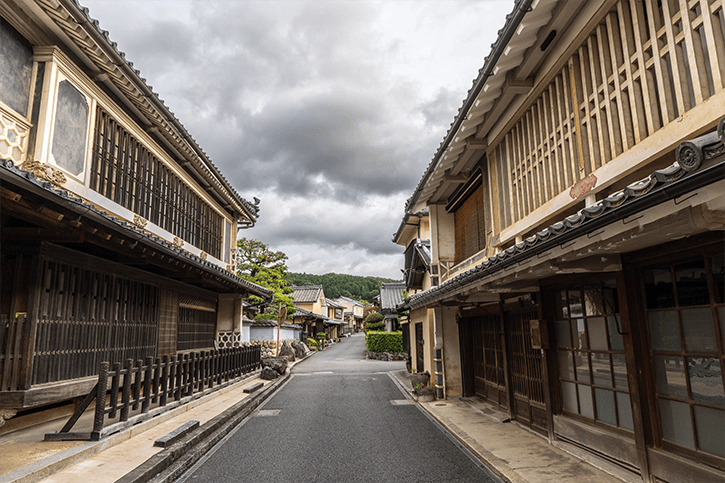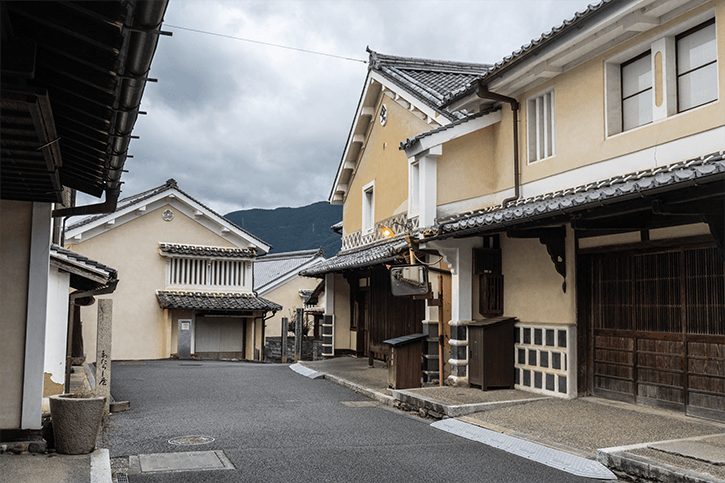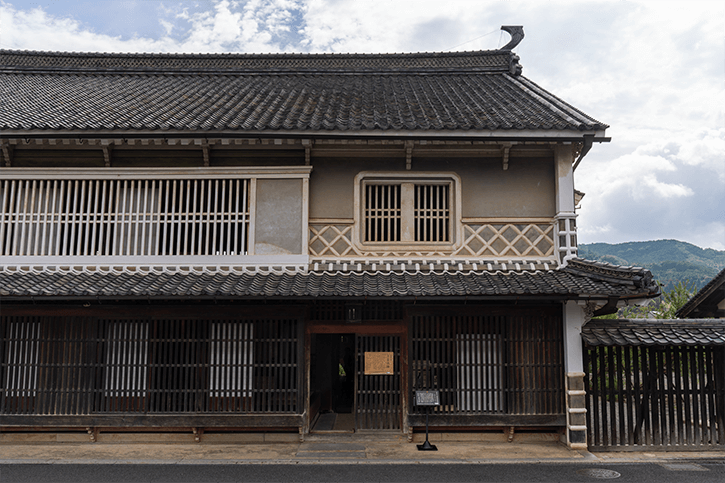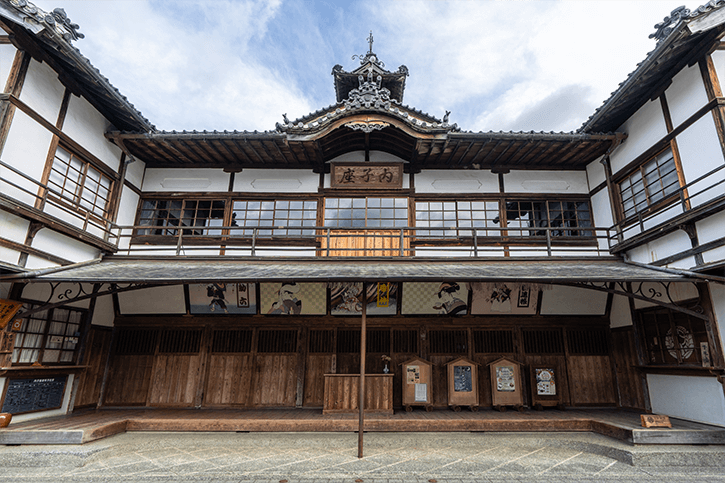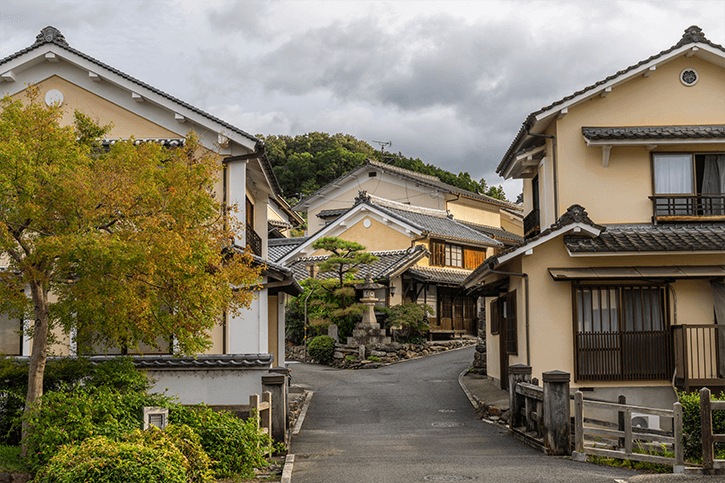
In Ehime Prefecture, the landlocked town of Uchiko presents a rare opportunity for visitors to experience preserved Japanese architecture from the late 19th through mid-20th centuries. Once a major center of production for Japanese wax, renowned overseas for its quality, the town had much of its old quarter left intact as the economy and the town architecture changed.
With its many cultural attractions and nostalgic charm, this small town, population 15,000, packs a big punch. This article provides an overview of the main attractions, including the Japanese Wax Museum & Kamihaga Residence, Uchiko-za Theater, and Uchiko History and Folklore Museum, accessible with a combined ticket (adults 900 yen, children 450 yen).
-
01
Uchiko’s old quarter
Today you can walk through a 600-meter-long preserved quarter stretching along the Nakamachi district. Spread out on a gentle hill, the area is lined with about 90 historic merchant houses from the Meiji (1868–1912) and Taisho (1912–1926) periods. These elegant structures have traditional tiled roofs, cream plaster walls and wooden latticework known as kōshi. Some buildings owned by wealthy families are ornamented with features such as namako-kabe diamond-shaped wall patterns.
![]()
![The Nakamachi slope is lined with shops, cafés and inns]()
The Nakamachi slope is lined with shops, cafés and inns
![Namako-kabe ornamentation in the Nakamachi district]()
Namako-kabe ornamentation in the Nakamachi district
Running roughly north-south, the Nakamachi slope is home to the Japanese Wax Museum & Kamihaga Residence and also has restaurants, cafes, craft shops and traditional inns. It intersects with Honmachi street, where you can find the Uchiko-za theater and the Uchiko History and Folklore Museum.
-
02
Japanese Wax Museum & Kamihaga Residence
One of the most luxurious of Uchiko’s merchant houses is the Kamihaga Residence, once home to a prosperous family of wax makers. The main building here is thought to have been constructed in 1894, around when wax production in Uchiko reached its zenith, with the adjacent buildings added on around the turn of the century.
![The main building of the Kamihaga Residence dates to the late 19th century]()
The main building of the Kamihaga Residence dates to the late 19th century
Set on a lot of over 4,000 square meters, the residence is unusual in that it is both an opulent Meiji home and a workshop for wax manufacture as well as a modern museum about the history of wax making.
![The ornate latticework of the Kamihaga Residence]()
The ornate latticework of the Kamihaga Residence
Notable architectural details of the building include its heavy pillars and beams, mud walls, elegant lattice and wood finishes, tatami-lined corridors, and fusuma sliding doors adorned with unusual glass panels.
![Elaborately decorated interiors in the Kamihaga Residence]()
Elaborately decorated interiors in the Kamihaga Residence
In addition, six rooms were planned for the second floor of the main building but were never built, resulting in an open space where the structural elements of the house are exposed. For another glimpse of the family’s glorious heyday, you can walk through the small garden at the Honhaga Residence in Nakamichi, an important cultural property. The home is not open to the public but the beautifully manicured garden and opulent exterior of the house are testament to the family’s status.
-
03
Uchiko-za Theater
The Uchiko-za Theater is the jewel of historic architecture in Uchiko. Through the patronage of prosperous wax merchants, this grand theater was completed in 1916 as a wooden structure with a gabled, hipped and tiled roof.
![The exterior of Uchiko-za]()
The exterior of Uchiko-za
![Classified as an important cultural property in 2015, Uchiko-za Theater was completed in 1916]()
Classified as an important cultural property in 2015, Uchiko-za Theater was completed in 1916
![A pine tree curtain adorns the stage at the Uchiko-za]()
A pine tree curtain adorns the stage at the Uchiko-za
The Uchiko-za was originally used as a venue for Kabuki and Bunraku plays in addition to Rakugo storytelling performances and movie screenings. Following a restoration in the 1980s, it has been used for both contemporary and traditional performing arts, hosting about 60 performances a year. It retains its traditional box seating and seat numbering using the hiragana alphabet.
![The Uchiko-za was originally built for Kabuki and Bunraku performances]()
The Uchiko-za was originally built for Kabuki and Bunraku performances
The theater can seat 650 people. Its stagecraft features include the hanamichi (flower path) elevated walkway leading to the stage including the suppon (snapping turtle) trapdoor from which ghost characters make their entrance.
The basement below the stage is referred to as naraku (hell or abyss), from which the suppon is operated and the mawaributai circular portion of the stage can be rotated, both by hand. Designated an important cultural property in 2015, the Uchiko-za is a splendid example of Japanese architectural and theatrical craftsmanship.
